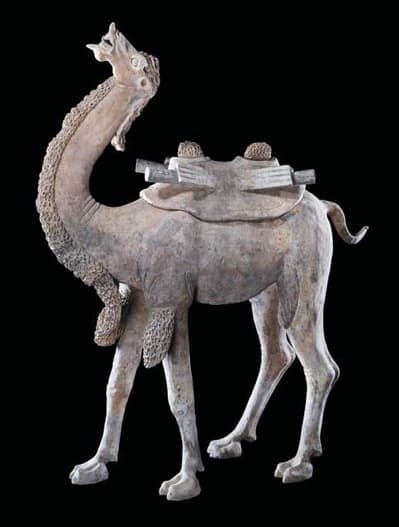T'ang Large Terracotta Sculpture of a Camel, 618 CE - 906 CE
Terracotta
height 88.9 cm
height 35 in
height 35 in
H.714
The T’ang Dynasty was an era of unrivalled wealth and luxury. The country was successfully reunified and the borders were expanded, pushing Chinese influence into new lands. Confucianism became a...
The T’ang Dynasty was an era of unrivalled wealth and luxury. The country was successfully reunified and the borders were expanded, pushing Chinese influence into new lands. Confucianism became a semi-religious instrument of the state; yet Buddhism continued to flourish, spreading into Korea and Japan. The arts reached new levels of sophistication. Poetry and literature flourished under the enlightened rulers. The Silk Road brought fortunes into China. Precious treasures were imported on the backs of camels from far away lands and bartered for Chinese silk, medicinal herbs, and pungent spices. T’ang China was a multicultural empire where foreign merchants from across Central Asia and the Middle East settled in the urban centers, foremost among them the thriving capital of Chang’an (modern X’ian), a bustling cosmopolitan center of over two million inhabitants. Foreign traders lived next to native artisans and both thrived. New ideas and exotic artistic forms followed alongside. The T’ang Dynasty was a cultural renaissance where many of the forms and objects we now associate with China were first created. Moreover, this period represents one of the greatest cultural outpourings in human history.
During the T’ang Dynasty, the beloved status of the camel ranked second only to the revered horse. Camels symbolized commerce and its associated wealth, largely concentrated on profits through trading on the Silk Road. Trade across this extensive network of paths and trails brought prosperity, foreign merchants, and exotic merchandize into China. However, the dusty trails of the Silk Road were an arduous journey through the rugged mountains and harsh desert of Central Asia that could only be traversed by the two humped Bactrian camel. This remarkable beast was able to withstand the scorching heat of the desert and to maintain its own nutrients, surviving for months without fresh supplies of water. The government kept vast herds of these invaluable creatures, presided over by civil officials, for hauling their precious commodities across the Silk Road. These exotic creatures were a common sight in the cosmopolitan cities of T’ang China, carrying both traders and their goods directly into the markets.
Likewise, T’ang artist began to create charming representations of these prized creatures as mingqi in order to symbolize wealth and prosperity in the afterlife. Mingqi were works of art specifically created in an ancient Chinese custom for interment in the tombs of elite individuals in order to provide for their afterlife. Some of the most beautiful works of Chinese art were excavated from such tombs, and this large sculpture of a camel is a perfect example of the refined artistry dedicated to such works even though they were never meant to be seen by the living. Standing with his head raised in the air and his mouth wide open, this camel is covered in thick tufts of furry hair along his head, neck, knees, and humps. Most remarkable, it features a removable saddle that may have even once supported an accompanying rider. This majestic sculpture reveals the T’ang Dynasty’s respect and admiration for this beast of burden, so essential to the prosperity of ancient China.
During the T’ang Dynasty, the beloved status of the camel ranked second only to the revered horse. Camels symbolized commerce and its associated wealth, largely concentrated on profits through trading on the Silk Road. Trade across this extensive network of paths and trails brought prosperity, foreign merchants, and exotic merchandize into China. However, the dusty trails of the Silk Road were an arduous journey through the rugged mountains and harsh desert of Central Asia that could only be traversed by the two humped Bactrian camel. This remarkable beast was able to withstand the scorching heat of the desert and to maintain its own nutrients, surviving for months without fresh supplies of water. The government kept vast herds of these invaluable creatures, presided over by civil officials, for hauling their precious commodities across the Silk Road. These exotic creatures were a common sight in the cosmopolitan cities of T’ang China, carrying both traders and their goods directly into the markets.
Likewise, T’ang artist began to create charming representations of these prized creatures as mingqi in order to symbolize wealth and prosperity in the afterlife. Mingqi were works of art specifically created in an ancient Chinese custom for interment in the tombs of elite individuals in order to provide for their afterlife. Some of the most beautiful works of Chinese art were excavated from such tombs, and this large sculpture of a camel is a perfect example of the refined artistry dedicated to such works even though they were never meant to be seen by the living. Standing with his head raised in the air and his mouth wide open, this camel is covered in thick tufts of furry hair along his head, neck, knees, and humps. Most remarkable, it features a removable saddle that may have even once supported an accompanying rider. This majestic sculpture reveals the T’ang Dynasty’s respect and admiration for this beast of burden, so essential to the prosperity of ancient China.



